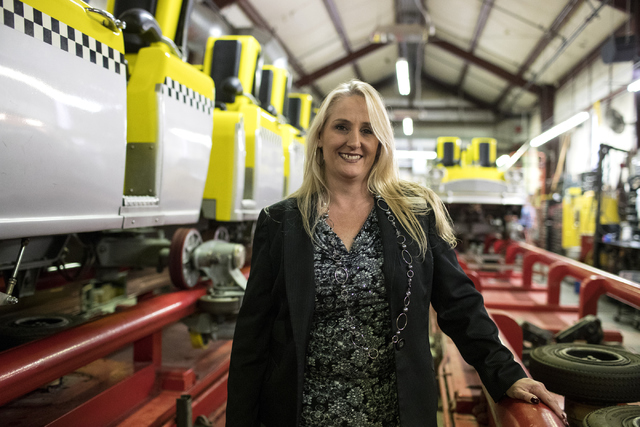Big Apple Coaster operations manager dreamed about working for attraction

For two and a half years, Wendy Ellebrecht’s morning routine involved careening down a hill at 65 mph, being turned upside down and whipping around a tight, stomach-churning spiral before coming to a quick and decisive stop three and a half minutes later.
“I’ve lost track of how many times I’ve ridden (The Big Apple Coaster at New York-New York),” Ellebrecht said. “When I was a supervisor I rode it at least every morning to check it out. I love roller coasters. I’m a thrill seeker.”
Maria Gomez and her friend Hector Sanchez were visiting from San Diego and just finished riding the roller coaster for the first time when they were told about Ellebrecht’s daily rides.
“No way,” Gomez said. “That’s crazy. You couldn’t pay me enough to do that.”
Sanchez, on the other hand, seemed excited about the prospect and was pondering a career change and move.
Ellebrecht has been working at the attraction for 18 years. When she moved to Las Vegas from California in 1999, her mother asked her what she would do here if she could do anything. She replied, “Work on that roller coaster.” She has risen to the top position there: operation manager.
“I started as a ride operator,” Ellebrecht said. “The training was all hands-on. I started by loading guests.”
The roller coaster and hotel opened just two years before she began working there. The ride begins with two drops, the first 76 feet and the second 144 feet. It has 4,777 feet of track with two inversions. It is unusual in that it goes around the towers of the hotel, with the majority of the ride hidden from view as the train climbs to the top of the 203-foot first hill.
The attraction has five trains, and two are running at all times. On busy days, as many as four trains can be on the tracks at one time, with two in the station and two in motion. The trains can be diverted to a side track for regular maintenance and repairs in a structure near the loading platform. Ellebrecht said the Big Apple Coaster has a great safety record.
“I have 10 maintenance guys and they’re wonderful,” Ellebrecht said. “We do daily checks, weekly checks and monthly checks; annually the trains get taken out and totally torn down and put back together. Once a month we walk the tracks, including the loops.”
Safety is built into the design of the attraction. Like most roller coasters, the one at New York-New York has six wheels at each end of each train car, with the main road wheels, side stop wheels and up stop wheels keeping the train on the track. The loud clacking noise associated with the chain-driven climb up the first hill is another safety feature.
“We call them anti-rollback dogs,” Ellebrecht said. “If we have to do a lift stop (stopping the train on the first hill), they catch and keep the train from coming backward.”
Most times when they have to do a lift stop, it’s because their cameras have spotted someone pulling out a video camera or a cellphone. When that happens, a staff member is obliged to walk up the stairs on the hill to collect the item, lest it get dropped and injure another patron.
“That’s really the only part of the job I don’t like, when guests yell at us because they don’t want to leave their cellphone in a locker,” Ellebrecht said. “This is such a fun place, and there shouldn’t be any reason that our guests shouldn’t have a fun time.”
Despite the staff’s best efforts, items do get shaken out of guests’ pockets.
“We find glasses, phones and hats, packs of cigarettes and more,” Ellebrecht said. “One time we found false teeth and another time we found a prosthetic eye.”
Everything found gets collected and returned to security’s lost-and-found department.
One exception is a single white glove that is on display in Ellebrecht’s office.
“That’s from the first wedding we performed here, on May 21, 2009,” she said.”The bride lost it on the ride and she said I could keep it.”
To reach East Valley View reporter F. Andrew Taylor, email ataylor@viewnews.com or call 702-380-4532.